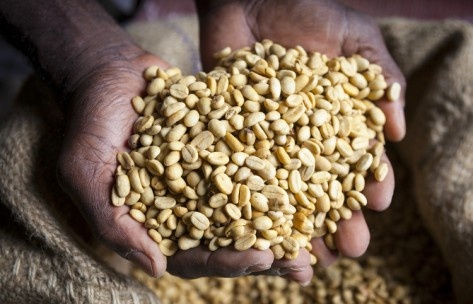Introduction to the flavor and taste characteristics of Ethiopian Yega Sheffield Adordo coffee with green citric acid flavor
In December 1994, the Constitution of the Federal Democratic Republic of Ethiopia was formulated. According to the Constitution, Ethiopia will implement a federal system and a parliamentary cabinet system after the general election for a term of five years. After the national election in May 1995, the Federal Democratic Republic of Ethiopia was established on August 22, and Meles became prime minister in her capacity as chairman of the majority party of the people's House of Representatives. On May 14, 2000, Ethiopia held a national election, and EGF defeated other opposition parties by an absolute majority to stay in power. In October, the new federal parliament and government were established, and the speakers of both houses and Prime Minister Meles were re-elected, and the original cabinet also remained in office with the approval of the parliament. In October 2001, May readjusted government institutions and reshuffled the cabinet, adding the Ministry of Youth, Sports and Culture and the Ministry of Taxation, and setting up a new cabinet composed of 18 ministers. In the fifties and sixties of this century, many African countries became independent one after another and adopted green, yellow and red as their national flags, so they were called "Pan-African colors." Ethiopia is one of the ancient countries in Africa, with a long history of more than 3000 years, giving green, yellow and red colors deeper roots in this land. Historically, they are closely related to the liturgy of the Coptic church, and are worshipped as the symbol of the trinity of the Father, the son and the Holy Spirit, reflecting the three virtues of loyalty, hope and kindness advocated by human freedom. These three colors also represent three regions of Ethiopia: Tikleh (red), Amhara (yellow) and Theo (green). Green represents fertile land, mild climate and rich plant resources, but also symbolizes hope for the future; yellow symbolizes peace and fraternity, as well as the people's determination to build the country; red symbolizes that the people are ready to shed blood and sacrifice to defend the motherland.
Yega Xuefei's coffee trees were planted by European monks (somewhat similar to Belgian monks who advocated planting wheat and brewing beer), and were later transferred to farmers or cooperatives. Yega Xuefei is actually built by surrounding coffee communities or cooperatives, including Edido, Hafusha, Hama and Bdon near the Fog Valley.
Most coffee beans are washed with water, but a few peas are deliberately sunburned to enhance their charming fruit aroma and mellow thickness. These mountain villages are foggy, like spring all year round, with a gentle breeze in summer, cool but not hot, rain but not damp, and no cold damage in winter, giving birth to a unique "regional flavor" of citrus and flower fragrance. Caffeine F trees are mostly planted in farmers' own backyards or mixed with other crops in farmland, and the yield per household is not much, which is a typical pastoral coffee. Almost all of the award-winning beans come from the above-mentioned coffee villages and communities.
The so-called "Yega Chuefei" refers to strong aromas of jasmine, lemon or green citric acid, as well as sweet peaches, almonds and tea. The author's tasting experience has only one sentence: "Coffee entrance, flowers in full bloom!" Except for the comfort of the taste buds and olfactory cells in the nasal cavity touched by flowers. In addition to the fragrance of flowers, the delicate mellow thickness is like silk and feels wonderful to the touch. At present, many coffee chemists are beginning to study the microclimate and soil and water around Yega Xuefei, in order to sum up the planting equation of fine coffee, Yega Xuefei, which originated in Ethiopia in eastern Africa, a small town named YirgaAlem location above, which is why it is named Yega Xuefei. The picture also shows Kenya, which faces Ethiopia to the south. Kenya is also one of the countries that produce boutique coffee beans. The northeast neighbor is Yemen, one of the three famous ancient coffee countries, separated by the Red Sea.
Different from other African countries, Ethiopia was invaded by Italy during World War II, but it was not engulfed by the wave of colonialism. Today, Ethiopia is one of the least developed countries in the world. Its weak industrial base is still dominated by agriculture and animal husbandry, and the environment has not been damaged by human development. Perhaps it is because of this that the natural high-quality natural environment has been preserved. This is also the reason why Ethiopia is called the cradle and hometown of native coffee varieties. There is no doubt that Yega Xuefei can produce such a delicious product. Ethiopia's climate is located in the tropics because of its latitude span and altitude difference, but the temperature is uneven in different places, ranging from 9.7 ℃ to 25.5 ℃, with an annual average temperature of 16 ℃. High altitude requires high altitude planting for high quality Arabica, which provides superior growth conditions at high altitude. The temperature difference range of 9.7 ℃ ~ 25.5 ℃ also provides a good growth temperature guarantee for high quality coffee beans with a growth temperature of 14 ℃ ~ 24 ℃. Every year, the heavy rainy season from June to September and the light rainy season from February to May ensure a sufficient supply of Rain Water. Therefore, with such a high-quality geographical environment and climatic conditions, there is no doubt that such a high-quality Yega Xuefei is produced.
Then thousands of years of Ethiopian planting history and processing tradition have created high-quality washed Arabica beans, and Yegashafi is synonymous with one of Ethiopia's boutique washed coffee. It has been a wetland since ancient times. The ancient saying "Yirga" means "settle down" and "Cheffe" means "wetland". Therefore, the mode of production and flavor of coffee here are outstanding, and it has become a famous coffee producing area in Africa. (at first, the coffee trees of Yega Xuefei were planted by European monks, and later by local farmers or cooperatives.)

Important Notice :
前街咖啡 FrontStreet Coffee has moved to new addredd:
FrontStreet Coffee Address: 315,Donghua East Road,GuangZhou
Tel:020 38364473
- Prev

Introduction to the coffee producing area of Larez Yaoke Coffee Manor in Puerto Rico with strong flavor and long aftertaste.
On September 23, 1869, the people of Puerto Rico were in R. Under the leadership of Emmetrio Betons, an uprising was held in the town of Larez (known as the voice of Larez in history), which declared the establishment of a republic on the 24th and was later suppressed by the Spanish colonial army. After a long struggle, Puerto Rico was finally granted local self-government by Spain. However, from then on, after the Spanish-American War, the island became an American colony, when
- Next

With excellent acidity Burundian coffee flavor, characteristics, taste and manor introduction
Burundi coffee was introduced by Belgian colonists in 1930. Unfortunately, many of these farms are on the border with war-torn Rwanda, putting pressure on coffee production. Coffee production in Burundi: Burundian coffee is now grown only on small farms. Almost all the coffee produced in Burundi is Arabian coffee beans, while
Related
- Detailed explanation of Jadeite planting Land in Panamanian Jadeite Manor introduction to the grading system of Jadeite competitive bidding, Red bid, Green bid and Rose Summer
- Story of Coffee planting in Brenka region of Costa Rica Stonehenge Manor anaerobic heavy honey treatment of flavor mouth
- What's on the barrel of Blue Mountain Coffee beans?
- Can American coffee also pull flowers? How to use hot American style to pull out a good-looking pattern?
- Can you make a cold extract with coffee beans? What is the right proportion for cold-extracted coffee formula?
- Indonesian PWN Gold Mandrine Coffee Origin Features Flavor How to Chong? Mandolin coffee is American.
- A brief introduction to the flavor characteristics of Brazilian yellow bourbon coffee beans
- What is the effect of different water quality on the flavor of cold-extracted coffee? What kind of water is best for brewing coffee?
- Why do you think of Rose Summer whenever you mention Panamanian coffee?
- Introduction to the characteristics of authentic blue mountain coffee bean producing areas? What is the CIB Coffee Authority in Jamaica?

